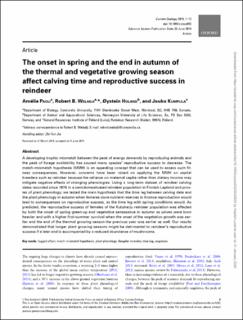| dc.contributor.author | Paoli, Amélie | |
| dc.contributor.author | Weladji, Robert B | |
| dc.contributor.author | Holand, Øystein | |
| dc.contributor.author | Kumpula, Jouko | |
| dc.date.accessioned | 2020-07-09T09:48:31Z | |
| dc.date.available | 2020-07-09T09:48:31Z | |
| dc.date.created | 2020-01-31T08:44:28Z | |
| dc.date.issued | 2019 | |
| dc.identifier.citation | Current Zoology. 2019, Volume 66, Issue 2, 123–134 | en_US |
| dc.identifier.issn | 1674-5507 | |
| dc.identifier.uri | https://hdl.handle.net/11250/2661586 | |
| dc.description.abstract | A developing trophic mismatch between the peak of energy demands by reproducing animals and the peak of forage availability has caused many species’ reproductive success to decrease. The match–mismatch hypothesis (MMH) is an appealing concept that can be used to assess such fitness consequences. However, concerns have been raised on applying the MMH on capital breeders such as reindeer because the reliance on maternal capita rather than dietary income may mitigate negative effects of changing phenologies. Using a long-term dataset of reindeer calving dates recorded since 1970 in a semidomesticated reindeer population in Finnish Lapland and proxies of plant phenology; we tested the main hypothesis that the time lag between calving date and the plant phenology in autumn when females store nutrient reserves to finance reproduction would lead to consequences on reproductive success, as the time lag with spring conditions would. As predicted, the reproductive success of females of the Kutuharju reindeer population was affected by both the onset of spring green-up and vegetative senescence in autumn as calves were born heavier and with a higher first-summer survival when the onset of the vegetation growth was earlier and the end of the thermal growing season the previous year was earlier as well. Our results demonstrated that longer plant growing seasons might be detrimental to reindeer’s reproductive success if a later end is accompanied by a reduced abundance of mushrooms. | en_US |
| dc.language.iso | eng | en_US |
| dc.rights | Attribution-NonCommercial-NoDerivatives 4.0 Internasjonal | * |
| dc.rights.uri | http://creativecommons.org/licenses/by-nc-nd/4.0/deed.no | * |
| dc.title | The onset in spring and the end in autumn of the thermal and vegetative growing season affect calving time and reproductive success in reindeer | en_US |
| dc.type | Peer reviewed | en_US |
| dc.type | Journal article | en_US |
| dc.description.version | publishedVersion | en_US |
| dc.source.pagenumber | 12 | en_US |
| dc.source.volume | 166 | en_US |
| dc.source.journal | Current Zoology | en_US |
| dc.source.issue | 2 | en_US |
| dc.identifier.doi | https://doi.org/10.1093/cz/zoz032 | |
| dc.identifier.cristin | 1787447 | |
| dc.relation.project | Nordforsk: prosjektnr 76915 - ReiGN | en_US |
| cristin.unitcode | 192,10,1,0 | |
| cristin.unitname | Institutt for husdyr- og akvakulturvitenskap | |
| cristin.ispublished | true | |
| cristin.fulltext | original | |
| cristin.qualitycode | 1 | |

